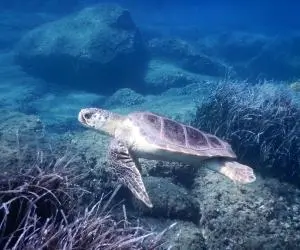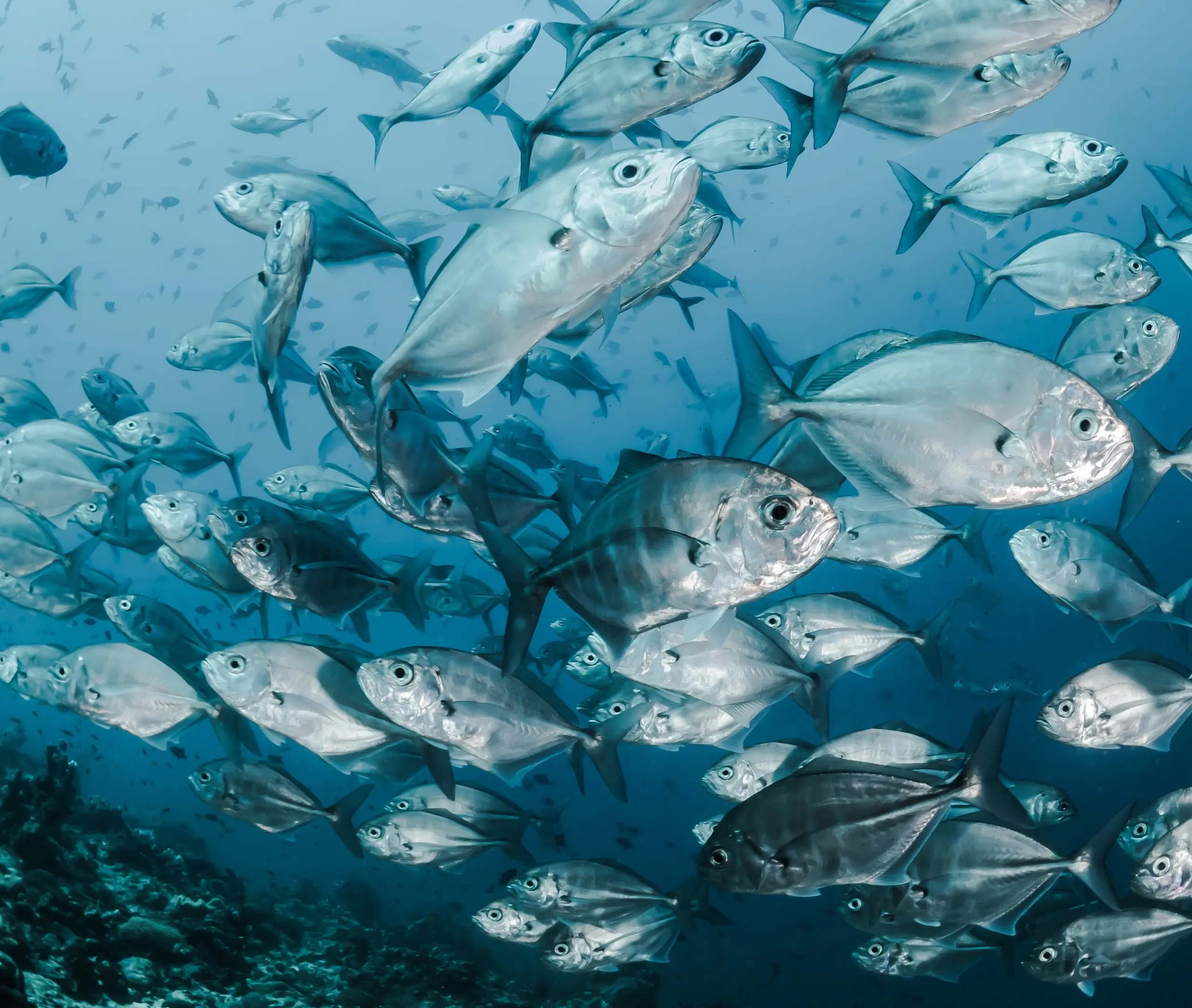Imagine a perfect day filled with excitement and wonder. Picture yourself snorkelling in crystal-clear waters, surrounded by a variety of colourful fish. Later, treat yourself to a delicious lunch at a cozy fish restaurant by the sea. But there’s more to this idyllic scene than meets the eye. Flourishing fish populations not only enhance the beauty of our oceans but also play a vital role in benefiting our society and economy. They attract tourists and support fishing industries.
In the pursuit to understand, protect, and manage our marine life, the European Tracking Network (ETN) takes the lead.
This Action tracks the movements of aquatic animals across Europe, uncovering the secrets of our underwater world. Dr Jan Reubens, Chair of ETN, shares with us his exciting journey at the helm of this network, diving into the mysterious depths of our oceans. Join us as we embark on an adventure of exploration, where snorkeling dreams merge with the important mission of preserving our precious marine ecosystems.
The power of collaborative animal tracking
Animal tracking has seen remarkable technological advancements, allowing us to monitor the movements of animals across larger and longer time scales. This progress has provided invaluable insights into the biology and ecology of marine animals. However, there is still much to be discovered and understood. To fully harness the potential of animal tracking, collaborative efforts and networks are essential.
In many cases, animals venture into regions where they go undetected due to the absence of monitoring infrastructure. The origins of the eel, for example, are a mystery that has endured since Aristotle, with scientists yet to pronounce a definitive answer. Conversely, there are instances where animals move through areas equipped with detection systems, but researchers fail to access that data due to lack of collaboration, compatibility or unawareness of existing infrastructure. By working together as a network, researchers can bridge these gaps and unlock a wealth of knowledge about animal movements and behaviour.
Fish tracking provides valuable information about the movements and behaviours of fish. By tagging and tracking fish, we gain insights into their patterns at different scales, ranging from local to global and from short-term to long-term periods (sometimes decades!). This data is essential for evidence-based management and conservation policies. Jan shared exciting examples of how biotelemetry has significantly improved our understanding of ecosystem functioning and dynamics, and how this knowledge contributed to evidence-based management and conservation policies.
Acoustic telemetry uses acoustic signals (also called ‘pings’) which propagate into the water, and are detected by acoustic receivers. Each tag has a specific set of ‘pings’ which are associated with a specific ID, allowing researchers to identify which animal was detected. The tags come in different sizes depending on the size of the animal you wish to tag, though smaller tags have a shorter battery life. This approach is by far the most widely used telemetry method.
One example involves observing fish behaviour to determine the best timing for and impact of construction works. Take wind farms for instance, where cod populations can be affected both positively and negatively. Wind turbines can serve as feeding grounds for cod, attracting them with abundant prey and shelter. However, during the construction phase, the noise can scare cod away, although they tend to remain in the area. Initiating construction activities during their feeding period might disrupt their feeding habits and force them into less favourable areas, potentially affecting their well-being.
Another crucial example involves eel escapements. Eels rely on the water current of rivers to navigate and find their way to the sea. However, obstacles like sluices and hydroelectric dams can harm them, and even often cause death. In some cases, if eels follow a canal, the changing current direction caused by sluices can trap them, leading to exhaustion and delayed arrival to the sea. Considering that their survival greatly depends on energy reserves available upon reaching the sea, these challenges have significant consequences for their population, particularly as they are considered critically endangered.
Species of interest to the European Tracking Network






Technology compatibility: a key factor for effective tracking
“What’s really important for us is technology compatibility” emphasises Jan. Tags from some manufacturers will not transmit to receivers of other manufacturers and as such researchers can’t mix & match equipment from different manufacturers so are tied to a single operating system. He explains that if different institutions use tags and receivers from different brands, they might not be able to detect the signals emitted by the tags. This is huge missed opportunity!
Existing long-term research projects focusing on large and wide-ranging pelagic species could be affected if global telemetry networks implement different operating systems. For example, tuna tagged in Europe with multi-year tags that work on the current system may not be detected by colleagues using another non-compatible system in North America. Additionally, species with unknown migration patterns may remain undiscovered.



It is an issue that many scientists were unaware of, “therefore, one of the top priorities of our Action was to ensure compatibility across different tag manufacturers. While we haven’t achieved 100% compatibility yet, we have made significant improvements, and we’re continuing our efforts to enhance compatibility in fish tracking technology” explains Jan.
The European Tracking Network managed to move forward towards a pan-European network that could provide relevant information in support of decision-making processes related to conservation and management of marine species. Collaborating with industry partners, the ETN has focused on developing new open tag protocols, aimed for the aquatic research community, so that everyone can ’listen in’ on aquatic life. These protocols will be available to all interested manufacturers and researchers and compatible with the most common existing and new equipment.
Open protocols encourage healthy and fair competition, and flexibility in choosing the best equipment, service and price. Opening the infrastructure networks of acoustic telemetry to all manufacturers of different types of sensors and tags drives innovation, and boosts availability of new solutions for future research. “We are aware of upcoming tag developments that will soon be released to the market. The tags will use these Open protocols, providing clear evidence of the innovation they bring”, says Jan.
ETN contribution to centralised data and collaboration
The ETN COST Action has been dedicated to advancing data centralisation and FAIR* data management across Europe. Centralised data plays a crucial role in avoiding duplicated efforts and facilitating research coordination on key species and arrays throughout Europe. It enables researchers to gather information over larger areas and longer time periods.
For instance, tuna tagged in Denmark have been detected in the Mediterranean, and sea-bass have been found to migrate over larger distances than initially anticipated.
ETN has taken the initiative to establish a central system and facilitate data sharing. Jan states, “We now have over 120 institutions using the system to integrate data.” The remarkable increase in detections, from 10 million to 750 million, showcases the growing interest in utilising this system.
“This is the result of the dedication and hard work of many people who invested their time to make this adventure a success! Personally, COST was completely new to me, so it was a steep learning curve assuming the role of Action Chair. However, COST provided good support and valuable networking opportunities, which have greatly contributed to our achievements!”
Dr. Jan Reubens, Chair of ETN
*FAIR: Findable, Accessible, Interoperable, Reusable.
ETN driving knowledge dissemination
The Action is actively working on the dissemination of its academic work to make it publicly available and shared with stakeholders. One of the major successes for ETN was also the high quality of it’s science communication output including the many videos produced by the network ranging from engaging animations to beautiful documentary-style videos.
Jan recognises that turning knowledge into policies is a lengthy process, which also varies depending on the country and its institutions. For example, in Belgium, efforts have been made to understand and address the declining sea-bass population. Collaborating with fisheries management organisations has played a key role in investigating this issue and exploring possible solutions.

The ETN Action network has ambitious plans and goals on the horizon. One significant achievement during the Action has been securing funding on a larger EU scale for the STRAITS project. This four-year Horizon Europe project aims to establish infrastructure at four strategic points in Europe, enabling the monitoring of animal migrations across ocean basins. These key locations include the Danish Straits, the North Channel, the Strait of Gibraltar, and the Strait of Bosphorus and Dardanelles. By deploying acoustic telemetry infrastructure, STRAITS will provide valuable insights into animal movements on a continental scale and cement a lasting impact for the work of ENT network.
Looking ahead, the European Tracking Network also intends to establish connections with other research communities, such as oceanographers and mammal researchers. By fostering collaborations, the network aims to enhance knowledge exchange and broaden the scope of its research. Furthermore, the network will continue its efforts in ensuring compatibility and driving technological advancements in the field of animal tracking.
Exciting proposals are already in the works, with more initiatives being prepared, so watch this space…







